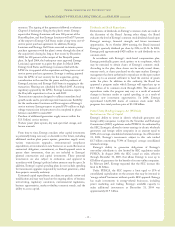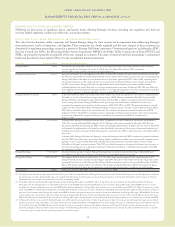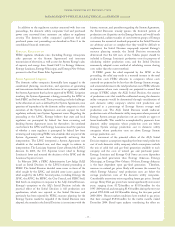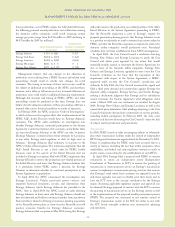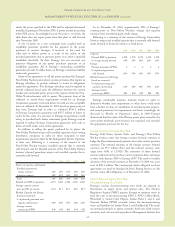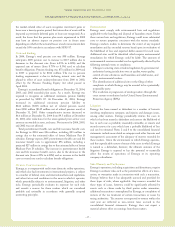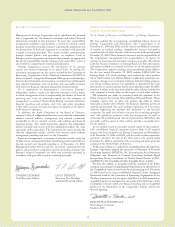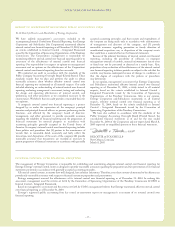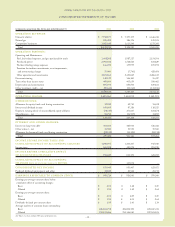Entergy 2004 Annual Report Download - page 41
Download and view the complete annual report
Please find page 41 of the 2004 Entergy annual report below. You can navigate through the pages in the report by either clicking on the pages listed below, or by using the keyword search tool below to find specific information within the annual report.
Entergy Corporation and Subsidiaries 2004
To the extent the Entergy companies are ordered to provide such
refunds, these costs will qualify for inclusion in the Entergy
companies’ rates. The recovery of these costs is not automatic,
however, especially at the retail level, where the majority of the cost
recovery would occur. Entergy intends to pursue all regulatory and
legal avenues available to it in order to have these orders reversed
and have the affected interconnection agreements reinstated as
agreed to by the generators.
Available Flowgate Capacity Proceeding
On December 17, 2004, FERC issued an order initiating a hearing
and investigation concerning the justness and reasonableness
of the Available Flowgate Capacity (AFC) methodology,
the methodology used to evaluate short-term transmission service
requests under the domestic utility companies’ open access
transmission tariff, and establishing a refund effective date. In its
order, FERC indicated that although it “appreciates that Entergy is
attempting to explore ways to improve transmission access on its
system,” it believed that an investigation was warranted to gather
more evidence in light of the concerns raised by certain
transmission customers and certain issues raised in a FERC audit
reportfinding errors and problems with the predecessor
methodology used by Entergy for evaluating short-term
transmission requests, the Generator Operating Limits
methodology. The FERC order indicates that the investigation will
include an examination of (i) Entergy’s implementation of the AFC
program, (ii) whether Entergy’s implementation has complied with
prior FERC orders and open access transmission tariff provisions
addressing the AFC program, and (iii) whether Entergy’s provision
of access to short-term transmission on its transmission system was
just, reasonable, and not undulydiscriminatory.
Entergy has submitted an Emergency Interim Request for
Rehearing requesting FERC to defer the hearing process and
instead proceed initially with an independent audit of the AFC
program and the expansion of the current process involving other
market participants to address a broader range of issues. Entergy
believes that this type of approach is a more efficient and effective
mechanism for evaluating the AFC program. Following the
completion of the independent audit and process involving other
market participants, FERC could determine whether other
procedural steps arenecessary. FERC has not yet ruled on the
Emergency Interim Request for Rehearing submitted by Entergy.
Entergy believes that it has complied with the provisions of its
open access transmission tariff, including the provisions addressing
the implementationof the AFC methodology; however, the
ultimate scope of this proceeding cannot be predicted at this time.
Ahearing in the AFC proceeding is currently scheduled to
commence in August 2005.
Federal Legislation
Federal legislation intended to facilitate wholesale competition in
the electric power industry has been seriously considered by the
United States Congress for the past several years. In the last
Congress, both the House and Senate passed separate versions of
comprehensiveenergylegislation, negotiated a conference package,
and fell two votes short of bringing the conferenced bill up for a
vote in the Senate. The bill contained electricity provisions that
would, among other things, allow for participant funding of
transmission interconnections and upgrades, repeal PUHCA, repeal
or modify PURPA, enact a mechanism for establishing enforceable
reliability standards, provide FERC with new authority over utility
mergers, and acquisitions, and codify FERC’s authority over
market-based rates. It is expected that the United States House and
Senate will again craft and consider energy legislation in the
109th Congress.
Market and Credit Risks
Market risk is the risk of changes in the value of commodity and
financial instruments, or in future operating results or cash flows, in
response to changing market conditions. Entergy is exposed to the
following significant market risks:
•The commodity price risk associated with Entergy’s Non-Utility
Nuclear and Energy Commodity Services segments.
•The foreign currency exchange rate risk associated with certain
of Entergy’s contractual obligations.
•The interest rate and equity price risk associated with Entergy’s
investments in decommissioning trust funds.
Entergyis also exposed to credit risk. Credit risk is the risk
of loss from nonperformance by suppliers, customers, or
financial counterparties to a contract or agreement. Where it is
asignificant consideration, counterparty credit risk is addressed in
the discussions that follow.
Commodity Price Risk
Power Generation
The sale of electricity from the power generation plants owned by
Entergy’s Non-Utility Nuclear business and Energy Commodity
Services, unless otherwise contracted, is subject to the fluctuation of
market power prices. Entergy’s Non-Utility Nuclear business has
entered into purchased power agreements (PPA) and other
contracts to sell the power produced by its power plants at prices
established in the PPAs. Entergy continues to pursue opportunities
to extend the existing PPAs and to enter into new PPAs with other
parties. Following is a summary of the amount of the Non-Utility
Nuclear business’ output that is currently sold forward under
physical or financial contracts at fixed prices:
2005 2006 2007 2008 2009
Percent of planned generation
sold forward:
Unit-contingent 36% 20% 17% 1% 0%
Unit-contingent with
availability guarantees 54% 52% 38% 25% 0%
Firmliquidated damages 4% 4% 2% 0% 0%
Total 94% 76% 57% 26% 0%
Planned generation (TWh) 34 35 34 34 35
Average contracted price per MWh $39 $41 $42 $44 N/A
The Vermont Yankee acquisition included a 10-year PPA under
whichthe former owners willbuy the power produced by the plant,
which is through the expiration in 2012 of the current operating
license for the plant. The PPA includes an adjustment clause under
-39 -
MANAGEMENT’S FINANCIAL DISCUSSION and ANALYSIS continued



